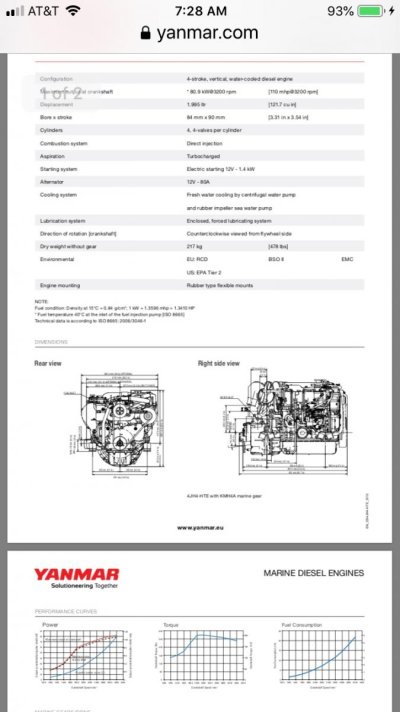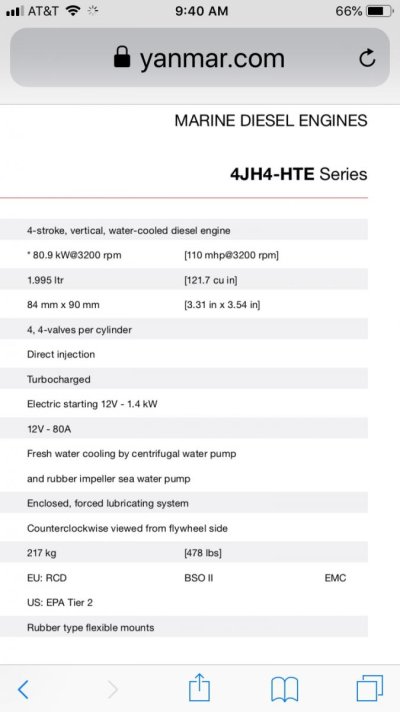cardude01
Guru
- Joined
- Nov 26, 2012
- Messages
- 5,290
- Location
- USA
- Vessel Name
- Bijou
- Vessel Make
- 2008 Island Packet PY/SP
Reading an article on engine loading where it recommends folks with lightly loaded engines should try to run the engine at around 75% of continuous rating to prevent glazing. Or if you can’t do that run it for high RPM/high loading every once in awhile to prevent cylinder wall glazing.
Excerpt:
“OK, now we know to run our engines hard to make them last, but how hard? Here I will defer to boat mechanical guru Steve D’Antonio, who recommends that diesels should be run regularly at about 75% power.
(By the way, you need to set the RPM at way higher than 75% of wide-open throttle RPM to actually load your engine at 75%.)
Now that doesn’t mean that to keep our engines healthy we must run them all the time at exactly 75% power. We don’t need to fixate on an exact number here. Rather we need to:
run at high power settings regularly,
and avoid running at less than about half power for long periods.”
I think I knew all this at one time, but I guess I forgot, because after installing the steady sails I have found myself pulling the throttle WAY back when I have some good wind to reduce engine noise and fuel burn but keep the same speed, usually around 6.5 knots at around 1800 RPM.
The problem with this (according to the article) is 75% of my continuous rating of 3100 RPM is 2325, so I’m not doing my engine any favors going so slow evidently. I’m heading for the Bahamas in June so I don’t want to run it too slow for long periods of time like I have been.
If I still want to enjoy my slow, quite 1800 RPM cruise how often (and what duration) should I run the engine up to a higher RPM, and what is that higher RPM? I really hate running it at 3000 plus.
What about changing the pitch of the prop to load the engine a little more? Dangerous I know if I decide I want (or need) to run faster for some reason after overpropping, but just wondering if any here have considered this?
I have a 110hp Yanmar 4jh4-HTE with max RPM of 3200 and a continuous rating of 3100. My boat weighs about 24000 LBs and has a 35’ LWL so a hull speed of 7.9 knots.
This engine seems to be way too big for this boat IMO, since trying to run at hull speed digs a big hole and it’s way too damn noisy with the engine right under the PH.

Excerpt:
“OK, now we know to run our engines hard to make them last, but how hard? Here I will defer to boat mechanical guru Steve D’Antonio, who recommends that diesels should be run regularly at about 75% power.
(By the way, you need to set the RPM at way higher than 75% of wide-open throttle RPM to actually load your engine at 75%.)
Now that doesn’t mean that to keep our engines healthy we must run them all the time at exactly 75% power. We don’t need to fixate on an exact number here. Rather we need to:
run at high power settings regularly,
and avoid running at less than about half power for long periods.”
I think I knew all this at one time, but I guess I forgot, because after installing the steady sails I have found myself pulling the throttle WAY back when I have some good wind to reduce engine noise and fuel burn but keep the same speed, usually around 6.5 knots at around 1800 RPM.
The problem with this (according to the article) is 75% of my continuous rating of 3100 RPM is 2325, so I’m not doing my engine any favors going so slow evidently. I’m heading for the Bahamas in June so I don’t want to run it too slow for long periods of time like I have been.
If I still want to enjoy my slow, quite 1800 RPM cruise how often (and what duration) should I run the engine up to a higher RPM, and what is that higher RPM? I really hate running it at 3000 plus.
What about changing the pitch of the prop to load the engine a little more? Dangerous I know if I decide I want (or need) to run faster for some reason after overpropping, but just wondering if any here have considered this?
I have a 110hp Yanmar 4jh4-HTE with max RPM of 3200 and a continuous rating of 3100. My boat weighs about 24000 LBs and has a 35’ LWL so a hull speed of 7.9 knots.
This engine seems to be way too big for this boat IMO, since trying to run at hull speed digs a big hole and it’s way too damn noisy with the engine right under the PH.

Last edited:

